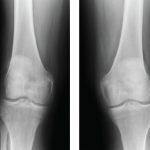People with crepitus “always” were three times more likely to develop arthritis over four years than those who never had it.
Older age and having crepitus also increased the likelihood of developing arthritis, and men with crepitus were more likely than women with noisy knees to go on to develop arthritis.
“Differences across genders is interesting and unexplained. This may tell us about differences in symptom reporting or the biology of osteoarthritis,” said Daniel Solomon, the chair of arthritis and population health at Harvard Medical School in Boston.
“Knowing how to predict who will develop symptomatic osteoarthritis may give patients and providers clues to who should receive earlier treatment or even prevention,” Solomon, who wasn’t involved in the study, told Reuters Health by email.
“It would be helpful to look at the MRIs of the people who had X-ray evidence, no pain and always had crepitus to understand what is happening in their knees,” Lo said. “This could help identify ways to decrease the risk for developing knee pain.”
Since MRI scans are more sensitive than X-rays, Lo added, researchers for future studies may be able to see osteophyte formations or other symptoms around the knee that they can’t usually see.
“Not all noises coming from a knee are a bad sign,” she said. “It might be helpful to ask your doctor for an X-ray to see if you have evidence of osteoarthritis and then take precautions from there.”
Reference
- Lo GH, Strayhorn MT, Driban JB, et al. Subjective Crepitus as a Risk Factor for Incident Symptomatic Knee Osteoarthritis: Data from the Osteoarthritis Initiative. Arthritis Care & Research (Hoboken). 2017 May 4. [Epub ahead of print]

